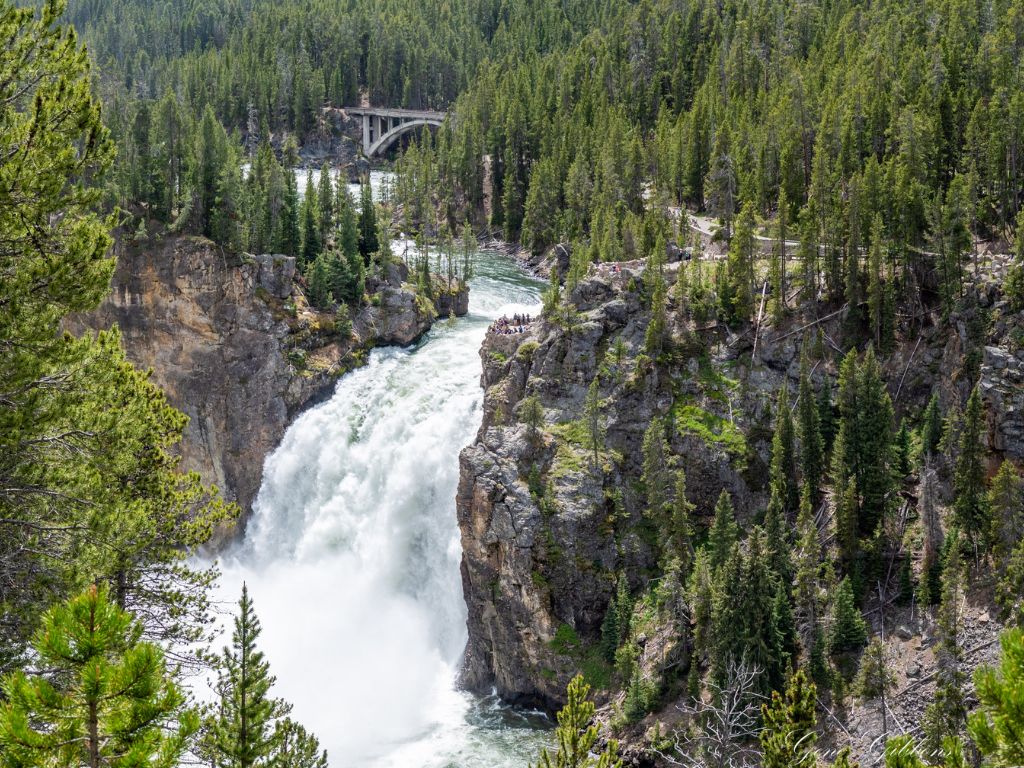The idea of setting aside land back in 1872 has spread into a movement across the world. When a nation creates a national park, it is a gift to the globe.

Yellowstone Falls in Yellowstone National Park. Photo by Gene Gibbons.
This article was produced exclusively for News Decoder’s global news service. It is through articles like this that News Decoder strives to provide context to complex global events and issues and teach global awareness through the lens of journalism. Learn how you can incorporate our resources and services into your classroom or educational program.
I vacationed this summer — like millions of others — in the much-loved United States National Park System (NPS).
My grandson Charlie and I spent a week hiking in the rugged splendor of Yellowstone and Grand Teton National Parks in the U.S. state of Wyoming, walking the same trails Native Americans used in the mountainous western United States centuries ago.
My grandson is 17. I’m 81. It was a memorable experience for us both. Charlie carried a 20-pound pack with our food, water and other necessities; I carried just a camera and even that seemed heavy.
I’m in excellent physical shape for someone my age but it was all I could do to keep up — the elevation gain during one 2.5 mile (4 km) stretch of trail was the equivalent of climbing 65 flights of stairs. Charlie easily handled the climb and wanted to push on into the deeper backcountry once we reached the pinnacle.
I was DONE.
“You can do that stretch of the trail with your grandson,” I said.
Protecting public places for posterity
We glimpsed moose and elk and saw foxes, pronghorn antelope and herds of bison. We even saw a grizzly bear with two of her cubs, albeit from a safe distance.
Yellowstone was the first national park in the United States, having been so designated in 1872 during the presidency of Ulysses S. Grant.
But Theodore Roosevelt, president from 1901 to 1909, is generally credited with having established the national park system we know today. It’s a sprawling expanse that preserves 85 million acres of public land for recreation and other non-commercial use.

Opening up nature to the world
In 2022, the NPS drew 311 million recreational visitors, many of them non-Americans. According to the U.S Travel Association, more than a third of the tens of millions of international tourists who come to the United States every year spend some time in a national park.
Because of this, many park employees are bilingual and maps, pamphlets and other printed materials are available in many languages.
What began in the United States has become an international reality. More than 100 countries now have national parks, like Croatia’s Plitvice Lakes National Park with its stunning necklace of lakes and waterfalls. Some preserve thousands of acres of unusual natural beauty.
Others, like Tanzania’s Serengeti National Park, protect the habitats of lions, tigers, elephants, giraffes and dozens of other animals indigenous to Africa. Chile’s Torres del Paine National Park, meanwhile, not only conserves some of the world’s most beautiful mountain peaks and glaciers but also is home to an array of wildlife that includes pumas, penguins and whales.
Providing space to breathe in a crowded world
Yellowstone National Park was the first, noted NPS Spokesperson Ellie Stuckrath. “[It’s] the foundation for park preservation that spread around the globe,” Stuckrath said. “Today, organizations and agencies across the world preserve their country’s land, history and stories.”
Kristen Brengel is senior vice president of government affairs at the National Parks Conservation Association. “National parks protect some of our most iconic natural wonders, from Half Dome at Yosemite to the Chimney Tops at the Great Smoky Mountains to the Maritime Heritage Trail at (Key) Biscayne,” she wrote in an email. “Parks also preserve our heritage and the stories that unite and inspire us, from the battlefields at Gettysburg to human rights battles at (California’s) César E. Chávez National Monument.”
The experience I’ll remember most was a daybreak hike to Yellowstone Lake’s scenic Storm Point. The lake is the largest body of water in Yellowstone, covering 136 square miles with 110 miles of shoreline.
Dawn’s first light spread across the eastern horizon as we set off across a meadow, staying well clear of a herd of bison grazing nearby.
The trail led into a forest carpeted with sweet-smelling pine needles, then onto long rolling open terrain inhabited by a colony of large ground squirrels called marmots, and thence to a long sandy beach overlooking the water. The majestic Teton mountains reached into the sky in the distance. My grandson and I, along with four other hikers, were the only humans for miles around.
It was almost mystical.

When we create parks, we fight climate change.
There are 63 national parks in the United States. The Great Smoky Mountains National Park in North Carolina and Tennessee is the most visited, followed by the Grand Canyon in Arizona and Yosemite National Park in California.
The popularity of the parks is both a blessing and a curse; overcrowding has forced some of them to require reservations.
Climate change is an even greater challenge.
Widespread flooding caused by unusually heavy rains and snowmelt blamed on global warming forced Yellowstone to evacuate visitors and close for nine days in June 2022 and adverse weather conditions damaged many other parks.
Brengel said these disasters, coupled with chronic underfunding of the national parks, threaten not only the parks themselves but the economic well-being of surrounding communities.
“In 2022, 311 million park visitors spent more than $20 billion in local gateway communities while visiting national park sites across the country,” Brengel wrote. “This supported hundreds of thousands of jobs and contributed more than $42 billion to the national economy.”
For Charlie and me, our week hiking in Yellowstone and Grand Teton was priceless. The companionship we shared, enjoying the beauty of nature and the call of the wild in some of the most scenic settings in the United States will likely warm Charlie’s memories for the rest of his life.
I know they will warm mine.
Questions to consider:
- How can a national park be an international asset?
- How can setting aside land for a national park help fight climate change?
- Have you been to a national park and what about it do you remember? If not, is there a national park you would like to visit?

Gene Gibbons covered U.S. Presidents Nixon, Ford, Carter, Reagan, George H.W. Bush and Clinton during his career with Reuters and UPI. He was past president of the Radio-Television Correspondents Association and served as a Presidential Debate panelist in 1992 and as a Joan M. Shorenstein Fellow at Harvard’s Kennedy School of Government in 2010. An ex-U.S. Army officer, he once served as press aide to U.S. Vice President Hubert Humphrey. He is the author of the book "Breaking News: A Life in Journalism."
Read more News Decoder stories about conservation:
